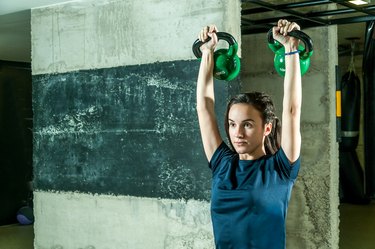
Overhead presses are the ultimate shoulder exercise, but not everyone can (or even should) do them. Whether it's due to lack of shoulder or spinal mobility, overhead pressing can be really challenging — and sometimes painful. But that's where the landmine press can help. This overhead exercise allows just about anyone to work and build their shoulders like a boss.
"What's great about using a landmine is that it can put you in a safer position to lift overhead because the bar is moving forward and away at an angle rather than directly up overhead," explains Sal Nakhlawi, a certified functional strength coach and founder of StrongHER Girls. Plus, because the weight is fixed to an attachment, it's easy to maintain control throughout the exercise and build balance and strength safely.
Video of the Day
So if you have trouble with overhead presses or just want to avoid potential shoulder issues in the future, the landmine offers a safer option for strengthening your delts and upper pecs.
- What is a landmine press? It's a shoulder exercise that involves pressing one end of a barbell overhead while the other end rests on the floor or in a landmine attachment.
- What muscles does the landmine press work? Whether you choose to press with both arms or one arm at a time, the exercise primarily works your shoulders, upper chest and triceps, according to Nakhlawi. To keep you stable, your core muscles also get in on the action.
- Who can do the exercise? Though the set-up can be a little intimidating for gym newbies, the exercise can actually be great for beginners, she says. It's also a solid option for people with limited mobility or who are rehabbing an injury. But if you have any current injuries or pain points, it's always a good idea to check with your physical therapist before trying a new exercise.
How to Do the Landmine Press With Perfect Form
Landmine Press
- Slip one end of your barbell into the landmine attachment sleeve and secure any weight to the free end.
- Stand facing the free end of the barbell and hold it with both hands at shoulder height, thumbs wrapped under the bar.
- Keeping your core braced and knees soft, press the bar up and away from you, fully extending your arms at the top.
- With control, lower the bar back down to the starting position.
Tip
Keep your elbows pointed straight down to the floor. If your elbows flare to the sides, you won't be able to press as much weight and could end up over-stressing your joints.
3 Landmine Press Benefits
1. Upper-Body Strength
Like any overhead pressing exercise, this move is a great way to build upper-body strength, Nakhlawi says. By incorporating this exercise into your routine, you'll challenge your shoulders as well as your chest, triceps and abs — muscles that help you perfect your push-ups.
Plus, if someone is hogging the dumbbells, power rack or upper-body pushing machine (like the shoulder press) at the gym, the landmine gives you another option for working that movement pattern.
2. Shoulder Safety
Compared with strict overhead presses, landmine presses put less stress on the shoulder joint and require less mobility through the shoulders and spine to do with great form, she says.
Because overhead presses carry a large risk for both acute and wear-and-tear injuries when performed without perfect form, landmine variations are ideal for protecting the joints.
3. Core Stability
Whether you perform this move in a kneeling, half-kneeling or standing position, your core muscles work to keep your body stable throughout each rep, Nakhlawi says. (It fires up more and more as you progress through these positions.) And, FYI, single-arm variations demand more stability than dual-arm ones.
"You have to engage your core to keep from feeling wobbly when pressing the weight overhead," she explains. "To stay squared forward — instead of shifting to the side or rotating — throughout the movement, you have to use your core."
4 Landmine Press Tips
1. Secure the Bar (and Weights)
Many gym's power racks have a landmine attachment — a metal sleeve that's on hinges — at the bottom of the rig. To set up, simply slide one end of the barbell into the landmine attachment.
Don't have access to a landmine attachment? Place one end of the barbell on the floor in a snug corner of a wall (a great option if you're working out at home) or a squat rack. You can also place it in the crook created by two heavy weight plates on the floor.
Once the bottom end of the bar is fixed on the floor, it's time to secure your weight plates (if you're using them). For safety, always fasten weight plates with a clip, just like during any other barbell exercise.
2. Clean the Bar
Once you've set up your barbell, you'll need to clean it up to your chest to start.
To do this, stand facing the free end of the bar and push your hips back to reach down and hold the end of the bar with both hands. (You can hold the bar with both hands in front of the weight plates if you're using them.) Keeping your core braced and back flat, push through your feet in the ground to stand, bending and tucking your elbows to let the bar rest in front of your chest.
Now you're ready to start pressing.
3. Balance Reps and Sets
The ideal number of sets and reps — and amount of weight to lift — are specific to your individual fitness level and goals. That said, 3 to 4 sets of 10 to 15 repetitions is a good place for most people to start, Nakhlawi says.
Generally, you want to pick a weight that makes the last few reps of each set difficult, but not impossible, to complete with good form. When you're done, you want plenty of gas left in the tank to be able to lower the bar to the floor with solid form (up next).
4. Reverse the Clean
When lowering the free end of the barbell back to the floor, it's important that you keep your back flat and shoulders nice and braced. This will reduce the risk of any jerking or excess strain on your muscles of joints.
To lower the weight, repeat the clean you used to raise the bar to your chest — just in reverse. Push your hips behind you then, one at a time, flip your hands around the bar so you can straighten your arms toward the floor. Keep your core and back braced. Don't let your shoulders round forward.
2 Regressions to Work Up to the Move
Move 1: Tall-Kneeling Press
- After setting up your barbell, face the anchor and get into a tall-kneeling position with your shoulders, hips and knees stacked. Hold the bar with both hands at chest height.
- Bracing your core, press the weight up and away from you until both arms are fully extended.
- With control, lower the weight back down to chest height.
If you feel unstable during standing presses or aren't comfortable cleaning the bar to your chest, start with this tall-kneeling shoulder press, Nakhlawi suggests. It can help you get comfortable with the movement pattern and equipment.
Move 2: Half-Kneeling Press
- After setting up your barbell, step one foot back and drop into a half-kneeling position so that your back knee is planted beneath your hip and your front leg forms a right angle. Hold the bar with both hands at chest height.
- Bracing your core, press the weight up and away until your arms are fully extended.
- With control, lower the bar back down to chest height.
Nailed the tall-kneeling press? Move on up to a half-kneeling position, which increases the challenge for your core as it works to keep you stable throughout the exercise. No worries, you'll still have an easier time balancing here than you would in a standing position.
2 Progressions to Make the Move Harder
Move 1: Single-Arm Press
- After setting up your barbell, stand facing the anchor and hold the bar with your right hand at chest height.
- Bracing your core, press the bar up and away from you until your right arm is fully extended.
- With control, lower the bar back down to the starting position.
- Repeat until all reps are done and then switch to the left side.
Once you’re comfortable doing standing presses with both hands gripping the barbell, add an extra challenge with a single-arm landmine press. This variation not only demands more stability from your core, but also from your shoulder joint.
Move 2: Standing Side-to-Side Press
- Stand facing the free end of the barbell and hold it with both hands at shoulder height. Rest the bar in front of your left shoulder.
- Keeping your knees soft and bracing your core, extend your arms to press the end of the bar up and away until your arms are both extended straight.
- With control, lower the bar down, this time lowering it to rest in front of your right shoulder.
- Repeat on the right side and continue alternating.
Want to really maximize this shoulder move’s core benefits? The side-to-side press requires your core muscles to fire up in a major way as you press and lower your bar from one shoulder to the other — without twisting your torso.


